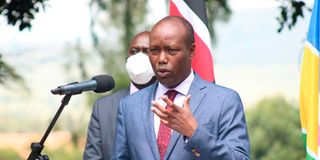New municipalities to get Sh100m each in grants annually

Nakuru Governor Lee Kinyanjui.
Molo and Gilgil towns in Nakuru County will each get Sh100 million annually in grants once they are elevated to municipalities.
The Nation has established that the towns will be elevated by May, after Governor Lee Kinyanjui received a report from ad hoc committees formed to spearhead the process.
“Molo and Gilgil towns are set to enjoy immense urban infrastructure development through increased funding to improve business and living conditions and attract investors once elevated. I will ensure they are elevated by May this year,” Mr Kinyanjui said.
The report will be forwarded to the county assembly for debate. Once approved, Section 9 of the Urban Areas and Cities Act empowers the governor, on the resolution of the assembly, to award the towns municipality status by granting a charter.
This comes after President Uhuru Kenyatta awarded Nakuru city status in December 2021.
Mr Kahiga Waitindi, the chairman of the ad hoc committee for Gilgil, said his team reviewed the town’s heritage, diversity, growth potential and need for government interventions.
His Molo counterpart, Mr Simon Matiri, said his team collected views from relevant sectors before unanimously endorsing the proposal to award the town municipality status.
The committees sought the views of residents and the business community at public participation events in the respective towns as required by the law and compiled a report, said County Attorney Caleb Nyamwange.
“Before President Uhuru Kenyatta conferred city status on Nakuru, we had two municipalities – Nakuru and Naivasha. With the elevation of Nakuru to a city, we want to upgrade the status of the other two towns to municipalities to attract more investors to the region,” he added.
This comes after the county cabinet adopted a report from the Department of Lands, Housing and Physical Planning in July last year that paved the way for the elevation of the two towns.
Governor Kinyanjui said the elevation will lead to programmes that will improve the towns’ appearance and competitiveness for investment and make them safer.
Under the Urban Areas and Cities Act, a town must have a population of at least 50,000 to be elevated to a municipality.
Gilgil sub-county has 185,209 people while Molo sub-county has 156,732, per the 2019 census.
The two, upon elevation, will become the second and third municipalities in the county, after Nakuru and Naivasha.
Molo was a town council before devolution.
Its growth was interrupted in 2007 by post-election violence, but over the last 14 years, the town has slowly picked itself up and grown in leaps and bounds, as residents strive to put the horrific past behind them.
The town, about 50km northwest of Nakuru city and off the Nakuru-Eldoret highway, was the epicentre of the 2007/2008 post-election violence in which thousands died, property worth millions of shillings was destroyed and over half a million people were internally displaced.
That was not the only time it had experienced chaos. In 1992, it was the locus of one of Kenya’s bloodiest conflicts that left thousands dead.
Fast-forward to 2021, Molo, avoided by investors because of its ethnic-clashes tag, has shaken off the bad name and is quickly becoming a key business hub and investment destination in Nakuru County.
Supported by the agriculturally rich areas of Njoro and Kuresoi, Molo has risen to a preferred business destination and everyone wants a piece of the cake.
Its commercial life is growing, with banks, telecommunications companies and others seeking to set up shop there.
It is one of the fastest-growing towns in Nakuru after Naivasha.
Competition for space is intense, from bars, restaurants, wholesale outlets and M-Pesa outlets to salons, barbershops, clothes shops and mini-supermarkets.
Vast and affordable land around Molo has also worked to its advantage as many other towns are running out of expansion spaces.
The availability of land for expansion in Molo and easy access to the Nairobi-Nakuru-Eldoret highway have contributed to the influx of investors, said economic expert John Kimani.
"Molo is also an agricultural town, basically supported by the rich agricultural areas of Molo, Kuresoi South and North, as well as Njoro. The town has grown because of the agricultural base," he said.
He added that the coming years will see businesses and companies relocate from Nairobi, Thika, Mombasa, Eldoret and Naivasha to Molo.
Molo MP Kuria Kimani, who has been rooting for the upgrading of Molo to a municipality, says the town is ready.
The MP says the town has grown into a business hub.
"I am optimistic about the economic growth of the town and I urge investors to invest in the town. The ghost of 2007 should not be held above our heads all the time,” he said.
“Residents are hardworking people who have moved on from the past and are ready to work with other Kenyans for the good of our country.”
He added: "The new status of Nakuru as a city will trickle down to the towns, but Nakuru is the new investment frontier in the country, with a wide range of opportunities."
If upgraded to municipalities, Gilgil and Molo will get funding from donors such as the World Bank to further improve infrastructure.





